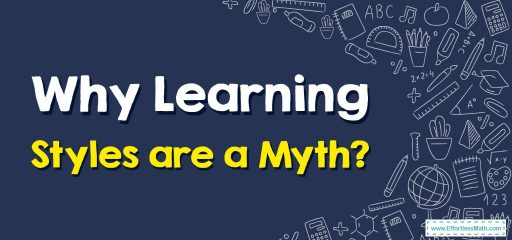Why Learning Styles are a Myth?

It’s a widely held belief in educational psychology that everyone learns best in a different way – that some people are visual learners, while others are auditory or kinesthetic. And based on this belief, there are countless learning style quizzes and assessments out there, designed to help students (and teachers) figure out the best way to learn.
But here’s the thing: the idea of learning styles is nothing more than a myth. Studies have shown time and time again that there is no evidence to support the idea that people learn better when information is presented in their preferred “learning style.”
Teaching to learning styles can do more harm than good. So why does this myth persist? And what should we be doing to ensure academic and career success? Keep reading to find out.
The Myth of Learning Styles
The theory goes like this: each person has a preferred way of taking in information and processing it. So, if we can determine what someone’s dominant “learning style” is, then we can deliver information to them in that way, and they will learn better. The problem is that there is no scientific evidence that this is true.
There is research that shows just the opposite – that trying to match instruction to so-called “learning styles” can be detrimental to learning.
Ask a professional essay writer to help you with this controversy.
The learning styles movement is often attributed to Howard Gardner’s theory of multiple intelligences. However, this is a misunderstanding of Gardner’s work.
While Gardner did propose that there are multiple ways of intelligence, he never suggested that curricula should be adapted to cater to different learning styles. Gardner has recently spoken out against the learning styles movement, saying that it is ‘fatally flawed.
The truth is that there is no evidence to support the idea that people learn better when information is presented in their preferred learning styles.
So why has the learning styles myth been so successful?
Part of the reason may be that it appeals to our natural tendency to want to find simple explanations for complex phenomena. When we hear about a new theory that seems to offer a simple solution to a complex problem, it can be very tempting to embrace it without fully examining the evidence. However, as educators, we must make decisions based on evidence, not just on what sounds good.
Another reason the learning styles myth is so pervasive may be that it’s simply more fun to teach in a way that matches our preferences.
If you’re a visual learner, then it makes sense that you would want to teach in a visually stimulating way. However, just because something is more enjoyable for us doesn’t mean it’s more effective for our students.
The Evidence Against Learning Styles
The first problem with the notion of “learning styles” is that it’s not clear what, exactly, a learning style is. Those who use the term don’t generally agree on what the criteria for a style are, or where styles come from in the first place. Is a learning style something that someone is born with? Something that develops over time? Something that can be changed at will? Nobody seems to know for sure.
Learning styles have been a hot topic in education for decades now, with countless studies and articles devoted to the subject. However, despite all of this research, there is still no clear consensus on what learning styles are, or whether they have any real impact on learning.
This lack of evidence has led some researchers to conclude that the whole concept of learning styles is nothing more than a myth. While this may be true, it’s important to remember that the absence of evidence does not necessarily mean that something doesn’t exist.
So while the jury may still be out on learning styles, it’s important to keep an open mind and continue to explore the possibility that they could play a role in improving educational outcomes.
Why Teaching to Learning Styles Can Be Harmful?
The theory of learning styles is based on the idea that people learn best when information is presented to them in their preferred learning style. For example, some people are said to be kinesthetic learners, and they learn best through tactile sensations.
The problem with learning styles is that they are oversimplifications of the way the brain works. The reality is that all people use all three learning modalities – visual, auditory, and kinesthetic – to some degree when they learn.
It’s not possible to change the way someone learns by simply changing the way information is presented. In other words, you can’t change a person’s learning style.
What’s more, the theory of learning styles can be harmful because it leads to labels and categorizations that can limit students’ potential.
For example, a student who is labeled as a “visual learner” may be told that they should only learn through visual means, such as books or diagrams. But what happens when she encounters a task that can’t be learned through vision alone, such as learning to ride a bike? The theory of learning styles would suggest that she is at a disadvantage because she doesn’t have the “right” kind of learning style for the task.
Solutions for Helping Students Learn Effectively
If we want our students to learn effectively, we need to base our instruction on methods that have been proven to work. And while there are many different instructional strategies out there, one of the most effective is known as “scaffolding.” Scaffolding is a method of providing support to students as they learn new information or improve their skills.
For example, if you were teaching a child to read, you would start by reading them simple books with lots of pictures and very few words. As they became more skilled at reading, you would gradually introduce more difficult material, until they were able to read on their own.
Scaffolding is an incredibly effective instructional strategy because it allows students to build on what they already know.
It also allows teachers to adjust the level of difficulty of the material based on the needs of each student. And perhaps most importantly, scaffolding has been proven to work – there is a great deal of research that shows its effectiveness.
To maximize your efficiency, don’t forget about using a test grade calculator as well.
So if you’re looking for an instructional strategy that will help your students learn effectively, scaffolding is a great option.
The Bottom Line
The bottom line is that there is no compelling evidence to support the use of learning styles in education. Teaching learning styles is not only ineffective, but it can also be harmful.
If you want to help your students learn, the best thing you can do is provide them with a variety of different experiences and let them find the ones that work best for them.
Related to This Article
More math articles
- 3rd Grade MCAS Math FREE Sample Practice Questions
- 3rd Grade NDSA Math Worksheets: FREE & Printable
- 8th Grade WY-TOPP Math Worksheets: FREE & Printable
- How to Stay Calm and Confident During a Math Test
- The Ultimate Trigonometry Course (+FREE Worksheets)
- How to Find Inverses of 2×2 Matrices?
- Top 10 4th Grade FSA Math Practice Questions
- How to Solve Point-Slope Form of Equations?
- How to Interpret STAAR Scores?
- Best Calculators for High School Algebra I






































What people say about "Why Learning Styles are a Myth? - Effortless Math: We Help Students Learn to LOVE Mathematics"?
No one replied yet.